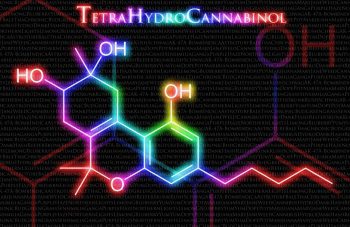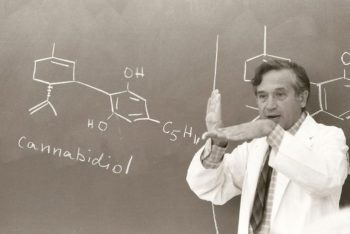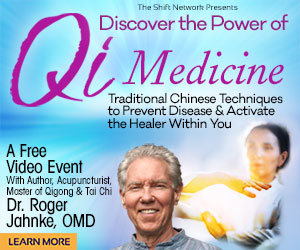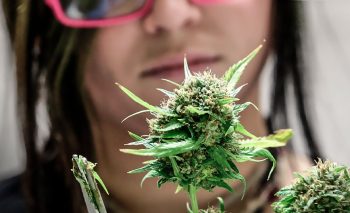By Marco
Guest writer for Wake Up World
Delta-9 tetrahydrocannabinol is indisputably the most well known component of the cannabis plant, and those three letters — THC — are almost as recognizable as the iconic marijuana leaf.
Many people only know tetrahydrocannabinol as the main cause of marijuana intoxication and see it as simply a tool for getting high, but the full story of this compound is a lot more complex.
We’re going to shed some light on this subject, because a complete understanding of THC is the foundation of canna-education. So, if you consider yourself a true cannabis aficionado, pay close attention.
To properly start this off, we need to explain what THC actually is and talk out about the function of the compound within the plant itself.
What is THC?
Tetrahydrocannabinol is the most abundant cannabinoid (an active chemical compound unique to cannabis) found in the cannabis plant. Most of the plant’s THC is located in trichomes, which are found on the flowers of fully grown female plants.
Adult male plants also contain THC, but in negligible quantities, so in order to feel the full effects of tetrahydrocannabinol, fully developed female plants must be used.
The way that THC and the majority of other cannabinoids (there are around 100 unique ones currently identified) work their magic in our body is by interacting with our internal endocannabinoid system. This causes a wide range of psychoactive and medicinal effects. But we’ll get to all that later.
You might be wondering: Why does cannabis have these cannabinoids in the first place?
Cannabinoid compounds aren’t needed for the growth, reproduction, or general development of the cannabis plant. Their function is to protect the plant from any outside attacks, acting like a vigorous immune system.
These types of chemical compounds are known as secondary metabolites, and in cannabis specifically, they are in charge of guarding the plant from herbivores, pests, viruses, bacteria, and parasites.
Another function of THC is that it decreases the harmful effects of the sun’s UV radiation, because of its powerful UV-B absorption. The majority of THC cannabinoids are located on the trichome glands of the flowers, which are found on the exposed outer surface of the buds.
Tetrahydrocannabinol (THC) is a chemical compound found only in the cannabis plant. It serves as a defense mechanism, protecting the plant from various predators, bacteria, parasites and also the radiation of the sun.
The Discovery of THC
The cannabis plant was greatly under-investigated before one man came along.
This figure, dubbed “The Godfather of THC”, is Raphael Mechoulam, now a well-established and famed Israeli organic chemist.
At the start of the 1960s, Raphael was working as a researcher at the Weizmann Institute of Science in Rehovot, Israel. Mechoulam had a deep-rooted fascination with cannabis, and was astonished that there weren’t any serious studies being done on this plant which he knew had been used as a medicine in many cultures for centuries.
He decided to take matters into his own hands, and through a connection of the Weizmann institute’s director he was able to acquire 5 kilos of impounded Lebanese hash from Tel Aviv’s police department. Mechoulam has said in interviews that this was an under-the-table, unofficial type of deal, so he felt pretty nervous transporting such a massive quantity of hash on the bus ride from Tel Aviv back to Rehovot.
After getting the required material for his research, Rafael and his team first successfully isolated an important cannabinoid, the non-psychoactive CBD, in 1963.
One year later, tetrahydrocannabinol was discovered. The researchers mapped its structure and were able to synthesize THC.
After these breakthroughs, Mechoulam no longer needed to use back doors to get the hash required for his work. The Israeli Ministry of Health began supplying his team with all the material they needed.
Dr. Mechoulam also discovered the human endocannabinoid system, which has important functions in pain, memory, mood, and a number of other processes in humans, and the endocannabinoids which are the cannabinoids produced naturally within our bodies.
An important endocannabinoid is anandamide. It plays a role in appetite, motivation, pain, pleasure and it is currently of interest to researchers due to its role in the extinction of unnecessary memories. Anandamide lasts for a short period of time which is measured in minutes (unlike THC which can affect us for several days).
One of the most important functions of the endocannabinoid system is to maintain homeostasis, the stable balance of functioning within the body.
Our endocannabinoid system is also activated when we consume cannabis.
Dr. Mechoulam has stated that he has never tried cannabis, refusing to compromise the validity and integrity of his research.
“I have never used it,” he said. “As I did research and we had an official supply of cannabis, obviously if we had used it for non-scientific reasons if people had come to know about it that would have stopped our work. Basically, neither I nor my students were interested.”
Tetrahydrocannabinol was discovered in 1964 by the Israeli organic chemist Dr. Raphael Mechoulam. The famed chemist also made several other important contributions to the science of cannabis, such as the discovery of the endocannabinoid system, and the isolation of CBD.
How THC affects our body
Now that we’re familiar with the endocannabinoid system (or the ECS) and our internal endocannabinoids, we can go further in depth into how THC (and other cannabinoids from cannabis) engage this network.
Parts of the ECS that are in charge of reacting to stimuli are called cannabinoid receptors, and once THC reaches these receptors they become influenced by the cannabinoid.
Once altered by THC, they “inform” other parts of the ECS to perform various chemical processes inside our body.
Cell sites that react to THC are located in three sections of our brain:
- The hippocampus – located in the temporal lobe of the brain and responsible for memory formation. The effects of THC on the hippocampus can affect short term memory.
- The frontal cortex – where our thought processes occur and cannabinoid receptors in this part of the brain can regulate our thought patterns. THC causes the firing of neurons to be quicker than usual, which results in a more flowing train of thought that is closely linked with creativity.
- The cerebellum – in charge of movement and general coordination which is why we tend to feel slightly clumsy and uncoordinated when high.
The increased release of dopamine is another crucial factor for THC intoxication, and this chemical is a part of a primal reward system for desirable behaviors like reproduction and eating. Dopamine levels spike when the surge of THC reaches the brain, causing us to feel joyous, content, and euphoric.
Because of each individual’s unique personal chemistry, these effects can be happen in a lesser or greater amount.
While the majority of ECS cells are located in the brain and in the central nervous system, these cells are also found in many other parts of the body, including our reproductive organs, skin, and our digestive tract.
Once THC reaches these cell receptors of the ECS, it causes a chain reaction that makes various parts of our body perform differently than usual, and as we know, also makes us feel quite different than we normally do.
While people usually need some time to get used to the cognitive and behavioral changes that THC creates (because they can be quite overwhelming at first), a whole series of reactions unnoticeable by our mind also happen at the same time.
Tetrahydrocannabinol engages the receptors of our endocannabinoid system, which when activated trigger a wide range of different chemical processes within the body.
THC effects
Because the THC-caused effects are profoundly diverse, we’re going to separate them into three stand-alone categories, where we’ll elaborate in great detail the short-term, medicinal, and long-term effects of tetrahydrocannabinol.
Before we start I should mention just a few general positive effects, which include:
- Better mood
- Pain relief
- Relaxation
- Stress relief
- Increased sociability
Short term effects
Under short-term effects we’ll encompass all the immediate effects that happen after THC intake.
Depending on the method of consumption, effects can happen within minutes after THC gets into our system via the lungs (with vaping, smoking, dabbing etc).
When we consume tetrahydrocannabinol orally (with capsules, oils and other oral solutions), first effects start happening after about 30-60 minutes. The duration of the effects are also prolonged with oral consumption, lasting much longer than smoking or vaping.
A person’s unique individual chemistry is essential for the perception of the effects of THC, so one user might experience some of them in a far greater amount than somebody else. You can easily figure out how your body reacts to THC after a couple of sessions.
Another factor is the strain of cannabis used, as well as the concentration of THC of that particular strain, and the quantity of other cannabinoids present in the strain in question.
Here are the main short term effects you may experience:
- Euphoria
- Uncontrolled laughter
- Feeling uplifted and energetic
- Sense of relaxation
- Increased appetite (a.k.a the munchies)
- Increased heart rate
- Red eyes
- Dry mouth (so-called cotton mouth effect)
- Feeling drowsy or dizzy
- Relief from pain
- Feeling of physical heaviness
- Decreased spatial memory (you’ll get lost more easily)
- Decreased body temperature
- Anxiety and paranoia (these issues tend to happen more to people who are particularly sensitive to THC)
Short term effects can be described as the immediate sensations associated with THC consumption. The intensity of these effects greatly vary from person to person.
THC benefits (medical)
Cannabis can help treat symptoms of an astonishing number of diseases and health conditions.
Probably the most amazing use of THC is in its battle against cancer cells. Animal clinical tests have shown that the THC compound causes cancer cells to commit autophagy (or cell “suicide”), and thus stops the proliferation and growth of certain tumors.
See: Over 100 Scientific Studies Agree: Cannabis Annihilates Cancer
Also, the anti-inflammatory qualities of THC makes this natural chemical a great aid for a wide range of modern diseases that have their root cause in inflammation such as the majority of autoimmune diseases, depression and neurodegenerative illnesses.
See: 5 Diseases Proven to Respond Better to Cannabis Than Prescription Drugs
Some of the conditions that THC (cannabis) has been proven to help include:
- Cancer
- Crohn’s Disease
- Insomnia
- Parkinson’s Disease
- Stroke
- Chronic pain
- ADHD
- Arthritis
- Alzheimer’s Disease
- Glaucoma
- Migraines
- Multiple sclerosis (and other similar disorders)
- Fibromyalgia
- PTSD
Cannabis is the most versatile medicinal plant known to man, and its main constituent (THC) is responsible for a colossal range of benefits, for numerous conditions that are listed above.
Long-term effects of THC
The research on the long-term effects of THC (and cannabis in general) is still quite limited. The scientific studies conducted so far frequently offer conflicting results but there is general agreement on some negative long-term effects of THC use.
Increased tolerance
If you frequently consume large quantities of cannabis, your body becomes more tolerant to THC and other cannabinoids. This means you’ll need to consume larger amounts of cannabis to achieve the same effect, and for genuine pot-lovers this is a very frustrating occurrence.
The best and only way to decrease your tolerance levels is to take a break from THC, and your sensitivity to cannabinoids will quickly recover.
General lack of interest
This is another issue that happens to users who excessively consume THC, and the feelings of apathy and emotional numbness can really interfere with your everyday life. You can fix this issue very easily by giving your body a brief period of time to recuperate from excess THC (7 days should be more than enough).
Problems for those predisposed for psychotic disorders
This particular study showed that frequent THC consumption in people who have a genetic predisposition to schizophrenia and other forms of psychosis can cause the initial symptoms of psychosis to develop earlier. If you’re at risk of such illnesses, you should stay away from tetrahydrocannabinol.
Altered memory
One study found that users who frequently enjoy THC experience a slight decrease of verbal memory over long periods of time. This may sound somewhat frightening, but the research showed that (on average) hard-core stoners lose only one word over a period of five years.
It’s essential to note that it’s utterly impossible to have a THC overdose.
An important thing that differentiates cannabis (and THC) from substances such as opioids, is that the receptors of the ECS aren’t stationed in the parts of the brainstem that control breathing. Because of this, too much THC cannot cause serious harm to any of our vital organs.
Scientists have calculated that a person would have to consume 40,000 times more THC than an usual dose (a joint) to overdose on it, which is just not doable in reality, so you can relax and be certain that you’re safe from overdose no matter how much THC you’ve ingested.
Another reassuring fact is that this particular study showed no measurable brain damage from THC in adults.
Bronchitis
This is not a problem which is directly connected with THC, but rather with smoking cannabis. Even if you’re smoking pure pot with organic rolling papers, over the course of an extended period of time you’ll most likely develop some sort of lung irritation.
This has nothing to do with THC (or weed for that matter), but is a problem with inhaling burned organic matter since combustion releases unhealthy carbon particles. These issues can be avoided by changing the way you consume cannabis (vaping/edibles being the best options for lung-health).
Prolonged exposure to THC can create several different effects including increased tolerance, feeling of apathy and a slight decrease of verbal memory. Also, people who are genetically predisposed to mental illnesses should avoid THC.
How to consume THC
All marijuana strains and species contain tetrahydrocannabinolic acid, or THCA, and we can consider that THCA is the THC compound, but in its raw natural form.
In its raw form, THCA cannot bind to the receptors of the endocannabinoid system, because it has one atom of carbon that’s stopping it to fit to the receptors of the ECS.
This is why nothing happens when we eat a bud.
In order for us to feel the effects of THCA, heat needs to be applied to cannabis, which removes the excess carbon atom from the THCA compound, and transforms it into the good old psychoactive and medicinally beneficial THC.
This process is called decarboxylation, and it functions exactly the same no matter if you’re smoking, vaping, making canna-butter, or consuming more potent forms of cannabis.
THC and CBD
Even though these are the two most prominent cannabinoids found in cannabis, they share very little resemblance. THC is found in much larger quantities than CBD (or cannabidiol), and unlike THC, cannabidiol doesn’t create any mental effects (it’s completely non-psychoactive).
These two chemicals also have a different way of interacting with our bodies.
THC produces its effects by binding to the receptors of our endocannabinoid system, and these receptors, once affected by THC, inform other parts of the ECS to perform various chemical tasks within the body.
CBD, on the other hand, has a completely different approach. It restricts the fatty acid amide hydrolase enzymes (FAAH) which are in charge of destroying our internal endocannabinoids (including anandamide), which then boosts the quantity of our endocannabinoids.
Besides the FAAH restriction, CBD also affects us in a couple of completely diverse ways, from activating our 5-HT1A hydroxytryptamine serotonin receptors (wonderful for anxiety), and TRPV1 receptors (great for mediation of pain perception, body temperature and inflammation).
CBD also diminishes the psychoactive effects of THC, which facilitates the medical benefits of tetrahydrocannabinol, because large doses of THC are known to cause feelings of paranoia and anxiety.
The combination of these two cannabinoids is amazing for treating illnesses and health conditions, because they play so well off each other.
Even though THC and CBD are very different and they access the endocannabinoid system through different “pathways”, they both have their own unique beneficial effects, but also cooperate great together, maximizing their therapeutic potential.
Also by Marco:
- Magic Mushrooms: New Research on Psilocybin and Its Benefits
- The Connection Between Cannabis and Meditation
About the author:

A passionate cannabis enthusiast ever since his late teens, Marco usually writes about 420 culture, health and weed basics. You can find him discussing various conspiracy theories with his peers.
You can follow Marco at Twitter.com/MarcoGreenCamp and GreenCamp.com.

If you've ever found value in our articles, we'd greatly appreciate your support by purchasing Mindful Meditation Techniques for Kids - A Practical Guide for Adults to Empower Kids with the Gift of Inner Peace and Resilience for Life.
In the spirit of mindfulness, we encourage you to choose the paperback version. Delve into its pages away from screen glare and notifications, allowing yourself to fully immerse in the transformative practices within. The physical book enriches the learning process and serves as a tangible commitment to mindfulness, easily shared among family and friends.
Over the past few years, Wake Up World has faced significant online censorship, impacting our financial ability to stay online. Instead of soliciting donations, we're exploring win-win solutions with our readers to remain financially viable. Moving into book publishing, we hope to secure ongoing funds to continue our mission. With over 8,500 articles published in the past 13 years, we are committed to keeping our content free and accessible to everyone, without resorting to a paywall.










